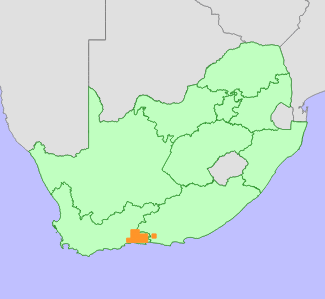|
Scientific Name | Leucospermum royenifolium (Salisb. ex Knight) Stapf |
Higher Classification | Dicotyledons |
Family | PROTEACEAE |
Common Names | Eastern Pincushion (e) |
National Status |
Status and Criteria | Least Concern |
Assessment Date | 2019/06/24 |
Assessor(s) | A.G. Rebelo, H. Mtshali & L. von Staden |
Justification | Leucospermum royenifolium has a restricted range (Extent of Occurrence 3936 km²), but is common across its range and it has no severe threats. Therefore it is not in danger of extinction. |
Distribution |
Endemism | South African endemic |
Provincial distribution | Eastern Cape, Western Cape |
Range | Leucospermum royenifolium occurs in the eastern Groot Swartberg, Kammanassie Mountains, northern foothills of the Outeniqua Mountains and in the Kouga Mountains as far east as Smutsberg, on the border between the Western and Eastern Cape provinces. |
Habitat and Ecology |
Major system | Terrestrial |
Major habitats | Kouga Grassy Sandstone Fynbos, Kouga Sandstone Fynbos, South Kammanassie Sandstone Fynbos, North Kammanassie Sandstone Fynbos, South Swartberg Sandstone Fynbos, North Swartberg Sandstone Fynbos, Tsitsikamma Sandstone Fynbos, South Outeniqua Sandstone Fynbos, North Outeniqua Sandstone Fynbos |
Description | It occurs on hot, north-facing quartzitic or sandstone slopes, 500-1800 m. It is a long-lived species, and survives fires by resprouting from an underground rootstock. Seeds are released after ripening, and dispersed by ants to their underground nests, where they are protected from predation and fire. It is pollinated by insects. |
Threats |
| Leucospermum royenifolium has no severe threats. Its habitat is remote and inaccessible, and most of it is protected. Climate change models predicted that it could decline by at least 30% by 2025 (Bomhard et al. 2005), but modelling did not consider that this species is an extremely long-lived resprouter, that is likely to persist in its habitat, and no such drastic population declines have yet been observed. It remains potentially vulnerable to climate change. |
Population |
This species is usually social, occurring in extensive stands (Rebelo 2001). It is not suspected to be declining.
|
Population trend | Stable |
Assessment History |
Taxon assessed |
Status and Criteria |
Citation/Red List version | | Leucospermum royenifolium (Salisb. ex Knight) Stapf | Least Concern | Raimondo et al. (2009) | |
Bibliography |
Bomhard, B., Richardson, D.M., Donaldson, J.S., Hughes, G.O., Midgley, G.F., Raimondo, D.C., Rebelo, A.G., Rouget, M. and Thuiller, W. 2005. Potential impacts of future land use and climate change on the Red List status of the Proteaceae in the Cape Floristic Region, South Africa. Global Change Biology 11(9):1452-1468.
Goldblatt, P. and Manning, J.C. 2000. Cape Plants: A conspectus of the Cape Flora of South Africa. Strelitzia 9. National Botanical Institute, Cape Town.
Manning, J.C. and Goldblatt, P. 2012. Plants of the Greater Cape Floristic Region 1: The Core Cape Flora. Strelitzia 29. South African National Biodiversity Institute, Pretoria.
Raimondo, D., von Staden, L., Foden, W., Victor, J.E., Helme, N.A., Turner, R.C., Kamundi, D.A. and Manyama, P.A. 2009. Red List of South African Plants. Strelitzia 25. South African National Biodiversity Institute, Pretoria.
Rebelo, T. 2001. Sasol Proteas: A field guide to the proteas of southern Africa. (2nd ed.). Fernwood Press, Vlaeberg, Cape Town.
Vlok, J. and Schutte-Vlok, A.L. 2010. Plants of the Klein Karoo. Umdaus Press, Hatfield.
|
Citation |
| Rebelo, A.G., Mtshali, H. & von Staden, L. 2019. Leucospermum royenifolium (Salisb. ex Knight) Stapf. National Assessment: Red List of South African Plants version 2024.1. Accessed on 2025/12/01 |
 Comment on this assessment
Comment on this assessment

